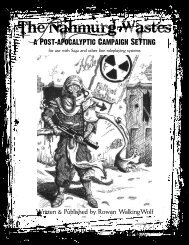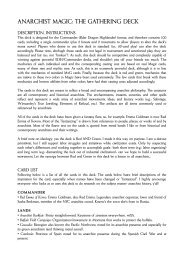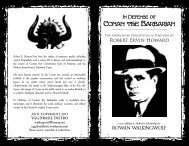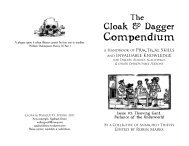Hyboria - WordPress.com - Yggdrasil Distro
Hyboria - WordPress.com - Yggdrasil Distro
Hyboria - WordPress.com - Yggdrasil Distro
Create successful ePaper yourself
Turn your PDF publications into a flip-book with our unique Google optimized e-Paper software.
Pictish Pictish Shaman<br />
The Pictish Wilderness, or Pictland, is the last remnant of the<br />
great uncivilized West which remains after the <strong>Hyboria</strong>n<br />
invasion. This region, which once stretched from the Western<br />
Ocean to the borders of ancient Acheron, now is reduced to a<br />
strip of wilderness a tenth its original size. Pictland is bounded on<br />
the north by the Eiglophian Mountains, on the east by the Black<br />
River, on the west by the ocean, and on the south by Zingara.<br />
The Pictish Wilderness is virgin forest, filled with oaks and<br />
maples, and haunted by creatures thought extinct by the<br />
<strong>Hyboria</strong>n world. <strong>Hyboria</strong>n scouts have reported saber-tooth<br />
tigers, giant pythons, apes and stegosaurs, as well as the more<br />
usual wolves, bears and elk. Nearly any forest creature (either<br />
modern or prehistoric) might be found somewhere in Pictland<br />
and the Pictish forests could conceal anything.<br />
In addition to the wide variety of normal animals, there are<br />
many creatures in the Pictish Wilderness who "remember" the<br />
worship of Jhebbal Sag. Such animals are slightly larger and<br />
more intelligent than normal, and are more easily controlled by<br />
Pictish shamans. The Picts worship the Animal Gods of the<br />
pantheon of Jhebbal Sag.<br />
Picts are a non-civilized people, short and swarthy, with broad<br />
shoulders, deep chests, and black eyes and hair. Their culture is<br />
focused around sustainable living, stone and bone tools, and only<br />
occasional us of "modern" weapons either bought from the<br />
Zingarans or stolen from Aquilonian troops.<br />
The Pictish tribes are very independent of one another. Each tribe is named for its totem animal, such as:<br />
Eagle, Hawk, Turtle, Bear, Wolf, Wildcat and Raven. Tribes are ruled by a chief, who is usually the best<br />
warrior, with the cooperation and support of the tribal shaman, although every individual has a say in<br />
decision making.<br />
Picts are consummate hunters and trackers. They have no agriculture or animal husbandry; their dinners<br />
are brought in through their hunting skill alone. They are also nearly invisible in the woods; western<br />
Aquilonian fortresses have a large ring of bare "killing ground" to prevent Pictish ambush.<br />
Picts have no understanding of <strong>Hyboria</strong>n chivalry. To a Pict, there is nothing wrong with sneaking up on<br />
your enemy and slitting his throat before he knows you are there. On the other hand, Picts in pursuit of<br />
an intruder run screaming through the forest as they get close, to bring fear to their enemies.Pictish<br />
weapons are the bow and the cast spear, the war club and the hatchet. They have little use for <strong>Hyboria</strong>n<br />
swords and battle axes, although they prize steel daggers and hatchet heads. They wear no armor.<br />
Not all Pictish relations are hostile. Zingarans occasionally sail north, trading Kushite ostrich plumes,<br />
jewelry, and weapons for skins, copper ore, and gold dust. Such trading is not without risk. A careless<br />
captain can quickly find himself on a sacrificial altar with Pictish hands at his ship's tiller.<br />
29







